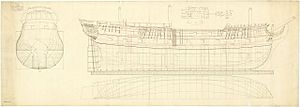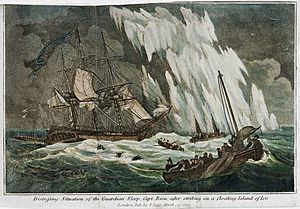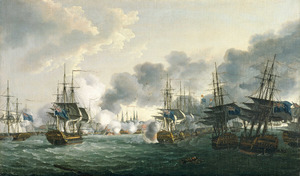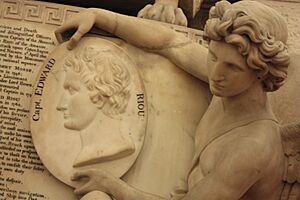Edward Riou facts for kids
Quick facts for kids
Edward Riou
|
|
|---|---|
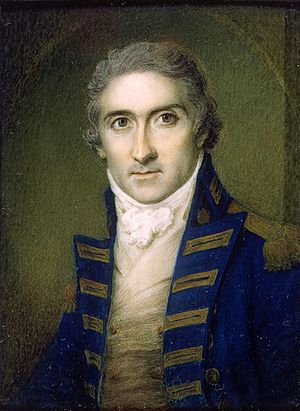
Captain Edward Riou, by Samuel Shelley, c. 1800
|
|
| Born | 20 November 1762 Mount Ephraim, near Faversham, Kent |
| Died | 2 April 1801 (aged 38) Aboard HMS Amazon, Copenhagen Harbour |
| Allegiance | United Kingdom of Great Britain and Ireland |
| Service/ |
Royal Navy |
| Years of service | 1774–1801 |
| Rank | Captain (Post-captain) |
| Commands held | HMS Guardian HMS Rose HMS Beaulieu HMS Princess Augusta HMS Amazon |
| Battles/wars | |
Edward Riou (born November 20, 1762 – died April 2, 1801) was a brave officer in the Royal Navy. He became famous for two amazing events during the French Revolutionary Wars. He served under some of the most respected naval leaders of his time.
Riou joined the navy when he was just 12 years old. He sailed in British and North American waters. Later, he was a midshipman on Captain James Cook's third and final voyage of discovery. Before this trip, a famous artist named Daniel Gardner painted his picture. Riou moved up through the ranks, serving in many different places. He also had times when he was out of work. In 1789, he got his first command: the ship HMS Guardian. This ship was used to carry supplies and convicts to Australia.
Riou's ship hit a huge iceberg, and it almost sank. After many tries to stop the water from flooding the ship, most of the crew left. Even though he expected to die, Riou refused to leave his ship. He and a few others stayed behind. They tried the almost impossible task of sailing the sinking ship hundreds of miles to land. After nine weeks at sea, with constant hard work, Riou successfully brought his half-sunk ship back to port. He saved the lives of everyone who stayed with him.
This incredible feat earned him promotions and new commands. But then he got sick and had to leave active service for a short time. He quickly got better and was given command of a new ship, the 38-gun HMS Amazon. In 1801, he joined Sir Hyde Parker's trip to the Baltic. Riou worked closely with Vice-Admiral Horatio Nelson before the Battle of Copenhagen. He earned Nelson's trust and respect. Nelson chose Riou to lead his frigate squadron during the battle. When the fight started badly for the British, Riou bravely attacked the Danish forts. He did this even though his ships were much smaller and had fewer guns.
When Parker sent a signal to retreat, Nelson ignored it. Riou felt he had to obey his commanding officer, even though he was sad about what Nelson might think of him retreating. As the Amazon turned away, it showed its weakest part to the Danish guns. Riou was encouraging his men until the very end. He was killed by a round shot (a cannonball). When Nelson heard about Riou's death, he said the loss was 'irreparable'. A monument was built to remember him in St Paul's Cathedral. A poem also honored the 'gallant, good Riou'.
Contents

Edward Riou was born in Mount Ephraim, near Faversham, Kent, on November 20, 1762. He was the second son of Captain Stephen Riou and his wife Dorothy. Edward started his naval career at age 12. He joined Sir Thomas Pye's large ship, the 90-gun HMS Barfleur, in Portsmouth. His next ship was the 50-gun HMS Romney. This was the main ship for Vice-Admiral John Montagu in Newfoundland.
By 1776, Riou was a midshipman. He joined Captain Charles Clerke's HMS Discovery for a trip to the Pacific. This was under Captain James Cook on HMS Resolution. It was Cook's third voyage of discovery. After Cook died in Hawaii, Clerke took command. He moved to the Resolution and brought Midshipman Riou with him.
Riou passed his lieutenant's exam on October 19, 1780. This was soon after the expedition returned to Britain. He was promoted on October 28. His first job as a lieutenant was on the 14-gun HMS Scourge. This ship was sent to serve in the West Indies. Riou got sick here, which was common for naval officers in hot climates. But he got better and returned to Britain. He left his ship on February 3, 1782, and went to the Royal Naval Hospital at Haslar.
He recovered his health. By April 1783, he was back on duty. He joined the Portsmouth guardship HMS Ganges. He left the Ganges in June 1784 and went on half-pay. This meant he got paid less because he wasn't actively working. This lasted for two years. Then, in March 1786, he got another job on the 50-gun HMS Salisbury. The Salisbury was the main ship for Rear-Admiral John Elliot. Elliot sailed to Newfoundland to become the Commodore-Governor there.
During this time, a sailor on the Ganges described Riou as 'a strict disciplinarian with a fanatical regard for cleanliness'. This means he was very strict about rules and keeping things clean. He was also known to be a religious man and a loving son and brother. After leaving the Salisbury in November 1788, he had another period of half-pay. But he had gained the attention of the Townsend family. With their help, he got command of HMS Guardian in April 1789.
The Guardian Adventure
The Guardian was a former 44-gun ship. But it had been changed to carry many supplies to the British colony at Botany Bay. These supplies included seeds, plants, farm tools, and animals. They were worth about £70,000. The Guardian also carried a number of convicts and their guards. A young midshipman named Thomas Pitt was on board. He was the son of politician Thomas Pitt and nephew of Prime Minister William Pitt.
Riou left Spithead on September 8, 1789, with over 300 people on his ship. The trip to the Cape of Good Hope was calm. There, he loaded more animals and plants. At the Cape, Riou met Lieutenant William Bligh. Bligh had sailed with Riou on Cook's third voyage. Bligh had been the sailing master of the Resolution. Bligh had just arrived at the Cape from Timor. He had sailed 3,618 miles in an open boat after a mutiny on his ship, HMS Bounty.
After getting all his supplies, Riou left the Cape in mid-December. He caught the Westerlies (winds) and began the second part of his journey to New South Wales. On Christmas Eve, twelve days after leaving the Cape, a large iceberg was seen. Riou decided to use the ice to get fresh water. His water supply was running low because he needed to water the plants and animals.
Hitting the Iceberg
Riou moved his ship close to the iceberg. He sent out boats to collect the ice. By the time the last boats were back, night had fallen. A sudden fog covered the iceberg. Riou was in a dangerous spot. A huge mass of ice was somewhere downwind, hidden in the dark fog. He put lookouts at the front of the ship and in the rigging (ropes and masts). He began to move slowly forward. After some time, the danger seemed to be over, and the iceberg was behind them.
But at 9 o'clock, a strange pale glow was reported by the lookout at the front. Riou ordered the steering wheel to turn sharply to the right. The ship turned into the wind as a wall of ice, taller than the ship's masts, slid by. It seemed they had avoided the danger. But as the ship passed, the Guardian hit an underwater part of the iceberg with a loud crash. A sudden gust of wind made the ship rear up and swing around. The stern (back) crashed into the ice, smashing the rudder, breaking the stern frame, and tearing a large hole in the hull. Even though the situation was very serious, Riou stayed calm. He used the sails to pull away from the ice. Then he checked the damage.
Now clear of the immediate ice danger, Riou faced a desperate situation. There were two feet of water in the bottom of the ship, and more was rushing in. The sea was getting rougher, and a strong wind had started. The pumps were working, but they couldn't keep up with the water. By midnight, there were 6 feet of water in the hold. At dawn on Christmas Day, they tried to 'fother' the hull. This meant lowering a sail packed with oakum (loose fibers) over the side to cover the hole and slow the flooding. This worked for a short time. By 11 o'clock, the pumps had reduced the water to 19 inches.
But the relief didn't last long. The sail ripped under the water's pressure, and the water level started to rise again. Some sailors asked if they could use the ship's boats. Riou convinced them to stay. Another attempt to fother the hull with a different sail failed when the sail immediately ripped. By nightfall on December 25, the water in the hold had risen to 7 feet. The ship was rolling violently, letting water pour over the sides. Riou ordered the supplies, guns, and animals to be thrown overboard to make the ship lighter. But he was hurt when his hand was crushed by a falling barrel while he was trying to clear the bread-room.
By the next morning, the ship was sinking by the stern (back). The sails had been torn away by the strong wind. Again, the sailors, joined by the convicts, asked to be allowed to use the boats. Riou finally agreed, knowing there weren't enough boats for everyone. He announced, 'As for me, I have decided to stay in the ship, and I will try to be useful as long as there is any need for it.'
Staying with the Ship
While the boats were getting ready, Riou wrote a letter to the Secretary to the Admiralty, the head of the navy.
Sir,
If any part of the officers or crew of the Guardian should ever survive to get home, I have only to say their conduct after the fatal stroke against an island of ice was admirable and wonderful in everything that related to their duties considered either as private men or on his Majesty's Service.
As there seems no possibility of my remaining many hours in this world, I beg leave to recommend to the consideration of the Admiralty a sister who if my conduct or service should be found deserving any memory their favour might be shown to her together with a widowed mother.
I am Sir remaining with great respect
Your ever Obedt & humble servt,
E. Riou
Riou gave the note to Mr. Clements, the master of the Guardian. Clements was given command of the launch (a type of boat). A total of 259 people chose to go in the five boats. This left Riou with sixty-two people. These included himself, three midshipmen (one was Thomas Pitt), the surgeon's mate, the boatswain, the carpenter, three convict supervisors, a daughter of one of the supervisors, thirty sailors and boys, and twenty-one convicts.
The Guardian was almost completely underwater by now, with 16 feet of water in the hold. But a bumping noise on the deck caught their attention. They found that several barrels had broken free and were floating in the hold, trapped under the lower gun deck. Riou realized this was helping the ship float. He had the gun deck hatches sealed and caulked (made watertight). Another sail was sent under the hull to control the flooding. Now, with his deck acting like a new hull, Riou raised what little sail he could. He began the long journey back to land. The pumps were worked constantly.
For nine weeks, Riou and his small crew sailed the Guardian. It was now little more than a raft. They traveled 400 leagues (about 1,200 miles) to the Cape of Good Hope. They saw the Cape of Good Hope on February 21, 1790. Whalers were sent from Table Bay to help the damaged ship to safety. Riou ran the ship aground to stop it from sinking. But a strong wind hit the coast soon after, completely wrecking the Guardian.
The journey was called 'almost without parallel' (meaning almost never seen before) by historian J. K. Laughton. Those who stayed with the Guardian were among the few who survived the accident. Of the boats sent out on December 25, only the launch with 15 people survived. They were rescued by a French merchant ship. The launch had seen the jolly-boat sink before losing contact with the two cutters and the long-boat. Riou arranged for the surviving convicts who had helped save the ship to be pardoned for their good service.
Promotions and French Revolutionary Wars
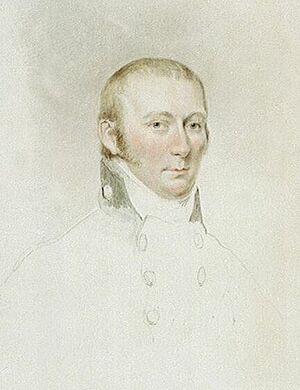
Riou returned to Britain and was praised by everyone for his amazing feat. He was found not guilty for the loss of his ship. He was promoted to master and commander on September 21, 1790. Then he became a post-captain on June 4, 1791. These promotions were for rank only. He didn't get a command until the French Revolutionary Wars began.
In June 1793, he was given command of the HMS Rose. He served in the West Indies with Sir John Jervis. He took part in battles against Guadeloupe and Martinique in 1794. In November 1794, he moved to the 40-gun HMS Beaulieu. He captured several small French ships. But then he got sick again and had to go home. Meanwhile, he was appointed to the yacht HMS Princess Augusta. But his health improved. He was able to return to active service in June 1799. He was given command of the 38-gun HMS Amazon. He fought against French privateers (private ships allowed to attack enemy ships). Then he was assigned to Sir Hyde Parker's trip to the Baltic in 1801. The goal was to make the Danes leave the League of Armed Neutrality.
In May 1796, he was chosen as a Fellow of the Royal Society. This is a group of very smart scientists.
Battle of Copenhagen
After the British forces looked at the Danish positions around Copenhagen, a meeting was held. Parker, his second-in-command Vice-Admiral Horatio Nelson, and other British captains were there. Riou was also present. Riou had worked closely with Nelson and Captain Thomas Foley before the attack. Nelson chose him to lead the frigates (smaller, faster ships) and other small vessels. He told Riou to place his ships to support the main fleet.
As the battle started, several of Nelson's large ships ran aground (got stuck) on shallow areas in the harbor. A new attack plan had to be quickly made. As Nelson's ships of the line fought the Danish ships, Riou took his frigates in. They attacked the Tre Kroner forts and blockships (ships sunk to block the harbor). Even though Riou's ships were much smaller and in a dangerous spot, they fought for several hours. The ships had many casualties (injured or killed sailors). Riou was hit on the head by a splinter (a piece of wood broken off by a cannonball).
Riou's Death
At 1:15 pm, Parker, who was waiting outside the harbor with the reserve ships, sent a signal. It ordered Nelson to withdraw (retreat). Nelson saw the signal but ignored it. Nelson's second-in-command, Rear-Admiral Thomas Graves, repeated the signal but also did not obey it.
Riou was in a difficult situation. He was too junior (low-ranking) an officer to risk disobeying a direct order. So, he sadly gave the order for his small group of ships to retreat. When they turned, their sterns (backs) faced the Danish guns. This left them open to heavy fire on their most vulnerable area. The retreat of HMS Alcmene and then HMS Blanche reduced the thick smoke from the guns. This smoke had been helping to hide the British ships. Now, the Amazon was fully exposed to the Danish guns. Riou continued fighting for another half an hour before sadly giving the order to withdraw.
Lieutenant-Colonel William Stuart, who led the soldiers of the 48th Regiment, wrote about Riou:
...was sitting on a gun, was encouraging his men, and had been wounded in the head by a splinter. He had expressed himself grieved at being thus obliged to retreat, and nobly observed, 'What will Nelson think of us?' His clerk was killed by his side; and by another shot, several marines, while hauling on the main-brace, shared the same fate. Riou then exclaimed, 'Come, then, my boys, let us all die together!' The words were scarcely uttered, when the fatal shot severed him in two.
Command of the Amazon then went to her first lieutenant, Lieutenant John Quilliam, who finished the retreat.
Remembering Riou
Nelson, who had not known Riou before this trip, had grown to like him very much. He wrote, 'In poor dear Riou the country has sustained an irreparable loss.' This means the country lost someone who could not be replaced. The naval historian Sir Jahleel Brenton said that Riou had all the qualities of a perfect officer.
The Parliament honored his memory with a monument. It is shared with Captain James Robert Mosse and is in the crypt (underground room) of St Paul's Cathedral. The poet Thomas Campbell wrote a poem called The Battle of the Baltic. It includes these lines about Riou:
Brave hearts! To Britain's pride,
Once so faithful and so true,
On the deck of fame that died
With the gallant, good Riou—Thomas Campbell, The Battle of the Baltic
Images for kids
-
Captain Edward Riou, by Samuel Shelley, c. 1800


